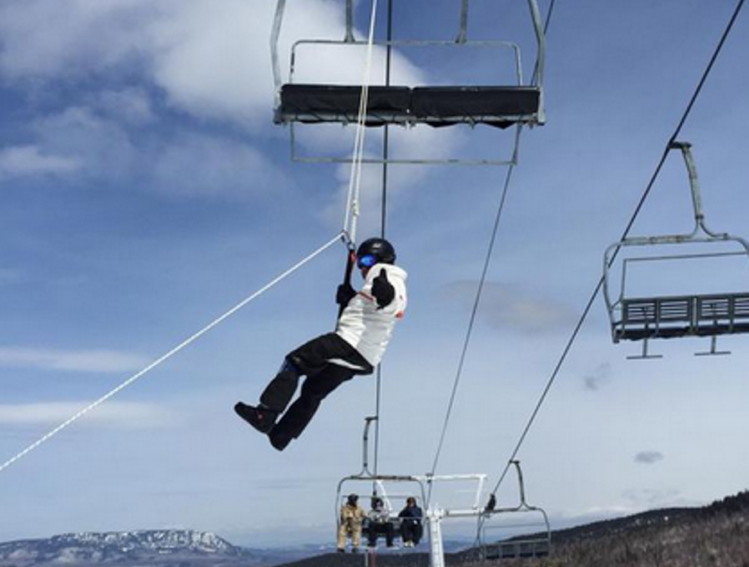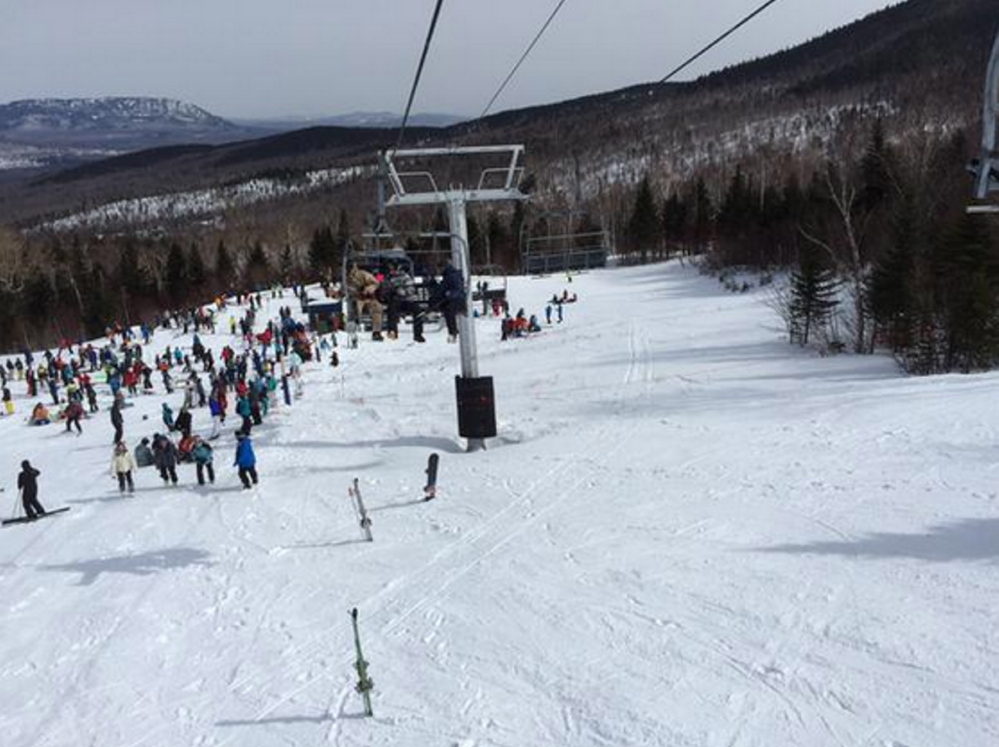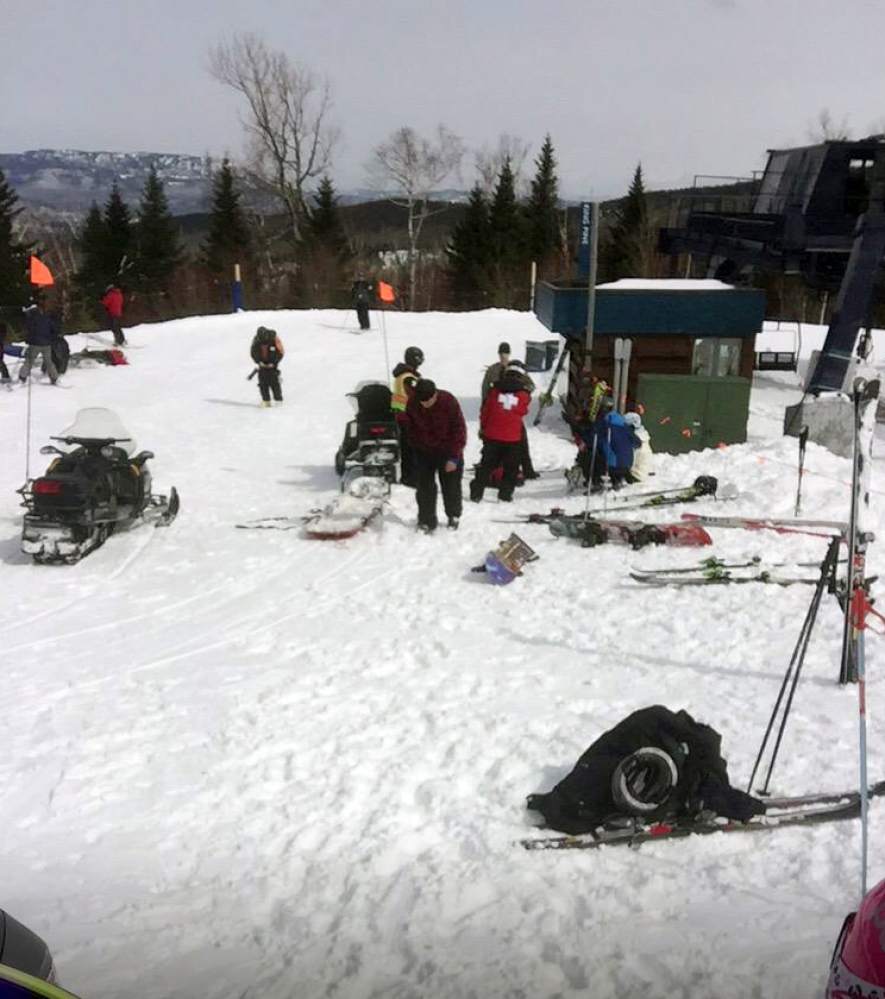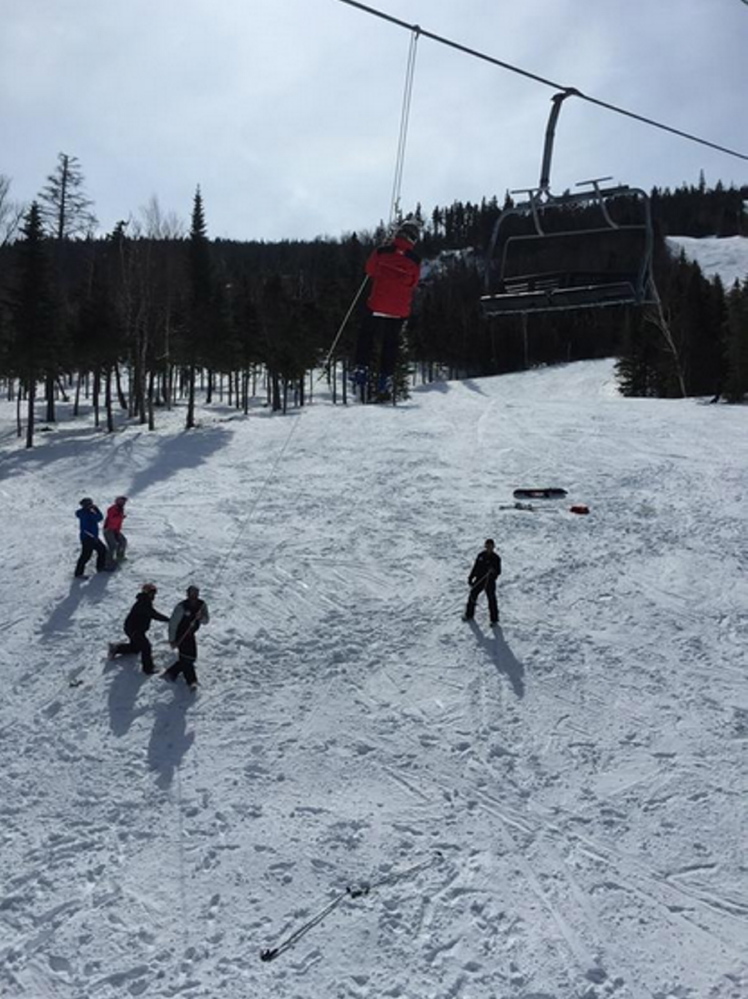A major mechanical failure triggered the chairlift accident Saturday at Sugarloaf ski resort in Carrabassett Valley that left seven people injured, according to results of an initial investigation.
More than 200 skiers were evacuated from the King Pine lift after it started going backward about 11:30 a.m. Saturday, prompting some frightened skiers to bail out.
The lift malfunction occurred in one of two gearboxes connecting the lift’s electric motor to its drive bullwheel, which is a large metal wheel supporting the cable connected to the chairs, according to a statement Sunday from Sugarloaf.
That gearbox on Friday passed a “sophisticated routine preventive maintenance procedure intended to identify potential problems,” the resort’s statement said. The King Pine quad lift’s gearbox last underwent major servicing, including the replacement of worn components, before the start of the 2011-2012 season, and the work was performed by a contractor who specializes in gearbox maintenance, according to the resort.
The accident investigation was expected to continue to search for the root of the mechanical failure, but Sugarloaf spokesman Ethan Austin said that probably will involve extensive analysis. The lift remained out of commission Sunday.
“Our first concern remains with those who were injured, and those who went through a truly frightening experience,” Austin said in the resort statement. “Based on what we know now, we’re grateful that this situation wasn’t any worse. It’s too soon to say what, if any, changes to operational protocols will be made, and part of that determination will hinge upon what’s revealed by the next stages of the investigation.”
Initial reports were that four accident victims were taken to Franklin Memorial Hospital in Farmington for treatment of injuries, but only three were treated there, according to the hospital. Two of them were treated and released, while a third was transferred to Central Maine Medical Center in Lewiston, a hospital spokeswoman said. It took the Sugarloaf Ski Patrol and other rescuers nearly two hours to evacuate the other skiers stranded on the stricken chairlift.
Austin said Sunday that many of the injuries occurred when people were hit by chairlifts near the chairlift terminal. Others suffered injuries “consistent with what you would expect from a 10-foot fall” from a chairlift, he said.
Resort officials did not release any information Sunday about the seven injured people, citing privacy issues. The injuries were described as not being life-threatening.
For a second day on Sunday, a representative of the State Board of Elevator and Tramway Safety, which regulates chairlifts, was at Sugarloaf to look into the accident.
In its statement describing the lift malfunction, the resort said “the gearbox failure effectively decoupled the bullwheel from the lift’s primary service brake, which is located on the drive shaft between the two gearboxes, and its anti-reverse brake, which is the first of three redundant backup mechanisms for preventing reverse travel.”
At that point, Sugarloaf added, “the emergency bullwheel brake, which uses calipers to apply braking pressure to the flange of the bullwheel itself, was applied by the lift attendant. This brake slowed the speed of the rollback and ultimately brought the lift to a stop. The application of the emergency brake by the lift attendant likely prevented a more extensive rollback.”
UNUSUAL INCIDENTS
As Sugarloaf officials worked Sunday to pinpoint the cause of the chairlift accident, others in the ski industry closely watched developments in Carrabassett Valley and a ski safety consultant said the type of chairlift malfunction that occurred there — a “rollback” — was unusual.
“I can’t tell you I have seen a lot of them,” said Mark Di Nola, a ski safety consultant in New Hampshire who serves as an expert witness in ski-related lawsuits.
This was the second chairlift malfunction in five years at Sugarloaf. In 2010 eight skiers were injured when high wind caused a derailment, and five chairs toppled 30 feet to the ground.
Di Nola said it is unusual for a ski resort to experience two chairlift accidents. He said Saturday’s rollback was also an unusual occurrence.
Ski industry standards call for lift operators to be trained and documented annually, but there is no standard that addresses how often lifts should be replaced, Di Nola said. He said the owners of the 27-year-old King Pine lift at Sugarloaf have gotten a useful life out of it.
“I can say it is not modern, with new technology, but how long lifts are supposed to last, I can’t tell you,” Di Nola said.
He said there are other ski lifts of similar age at resorts across the country. “Is that a cause for concern? It could be,” Di Nola said.
Sugarloaf operates 15 chairlifts. The King Pine lift, the one that malfunctioned Saturday, was installed in 1988 and was manufactured by Borvig Ski Lifts, which closed in 1993. There are only a handful of ski lift manufacturers.
Austin said King Pine is inspected daily, biweekly and monthly by the staff and undergoes an annual review by the State Board of Elevator and Tramway Safety. He said the state also requires every chairlift to undergo a full dynamic load test every seven years. The King Pine lift was put through that test in October.
“So it was thoroughly tested in the last several months,” Austin said.
Sugarloaf, which has 153 trails and glades, is owned by CNL Lifestyle Properties, a Florida real estate investment trust, and operated by Boyne Resorts of Michigan. The first ski trail on Sugarloaf opened in 1953. Today it is the largest ski resort east of the Mississippi, in terms of ski-able acreage.
Ski lift industry standards have been set by the American National Standards Institute, a private group that oversees voluntary standards.
Saturday’s accident has been followed closely by other ski resort operators, both nationally and in Maine.
Sarah Devlin, spokesman for Sunday River resort in Newry, said a ski lift accident always brings the issue of safety to the forefront.
“Safety is something we do consistently on a daily basis,” Devlin said.
Christopher Farmer, general manager of Saddleback Maine in Sandy River Plantation, said he had no comment other than to praise the handling of the accident by Sugarloaf’s staff and ski patrol.
Injuries and deaths from ski lift malfunctions are rare, according to the industry. The ski industry notes that riding a chairlift is safer than riding an elevator, and there has not been a death because of a mechanical malfunction since 1973.
The National Ski Areas Association, a trade group for ski resort operators, said between 1973 and 2012 there were 13 deaths and 62 injuries from lift malfunctions and falls in the U.S.
But ski lifts do malfunction regularly. On March 5, skiers in 20 cable cars were stranded for two hours in the Italian Dolomites when a tree fell on a cable and cut off power. About 80 skiers were left dangling 25 feet from the ground at the Pajarito Mountain ski resort in New Mexico on Feb. 15 when a ski lift became stuck. Some witnesses said it took about 90 minutes to be rescued.
NEGATIVE FALLOUT?
Whether the accident will have negative fallout for the state’s ski industry as it begins to wind down for the season is unclear.
Austin, the Sugarloaf spokesman, said earlier Sunday it is understandable for skiers there to have safety concerns following Saturday’s events. He said the resort will work hard to retain their trust by investigating the accident thoroughly and reporting the results promptly.
“It is a matter of demonstrating our dedication to safety and part of that is aggressively investigating what happened yesterday, sharing it and moving on from there,” Austin said.
Rick Tonge, of Belgrade, was among those was riding a 35-year-old double chairlift at Sugarloaf in 2010 when five chairs — including his — plummeted 30 feet to the snowy ground below, injuring him and his son.
On Sunday, Tonge told The Associated Press that Saturday’s accident probably will “bring it to people’s attention that something’s got to be done.”
“This is an old mountain,” he said. “It’s been around a long time.”
Tonge, whose back was hurt in 2010, worries that the resort has been slow to upgrade aging equipment. “They have plans in the works to replace lifts. There have been plans right along. But they’re late,” he said.
Steve Kircher, president of eastern operations for Boyne Resorts, which operates Sugarloaf, took exception to the notion that aging chairlifts lifts are problematic.
“Having literally grown up in the ski industry, I can tell you that age of equipment generally does not translate into higher risk,” Kircher told The Associated Press. “There are lifts operating successfully all over the world that are considerably older than King Pine. I’ve also been around long enough to know that new lifts can have mechanical issues.
Meanwhile, the U.S. Ski and Snowboarding Association said its confidence in Sugarloaf hasn’t been shaken by the chairlift malfunction, The Associated Press reported. Sugarloaf is hosting the U.S. Alpine Championships this week with top skiers such as Lindsey Vonn and Mikaela Shiffrin.
“We have been in touch with Sugarloaf. The lift in question has no impact on our event. We are confident in Sugarloaf’s ability to conduct our U.S. Championships,” spokesman Tom Kelly said.
At least one skier who was on the King Pine lift when it went backward was skiing again Sunday. Greg Hoffmeister of Needham, Mass., said he and his daughter jumped out from about 10 feet up, while his wife and two other daughters in another chair were rescued by the ski patrol.
“It was scary for sure,” he said.
Copy the Story LinkSend questions/comments to the editors.






Success. Please wait for the page to reload. If the page does not reload within 5 seconds, please refresh the page.
Enter your email and password to access comments.
Hi, to comment on stories you must . This profile is in addition to your subscription and website login.
Already have a commenting profile? .
Invalid username/password.
Please check your email to confirm and complete your registration.
Only subscribers are eligible to post comments. Please subscribe or login first for digital access. Here’s why.
Use the form below to reset your password. When you've submitted your account email, we will send an email with a reset code.